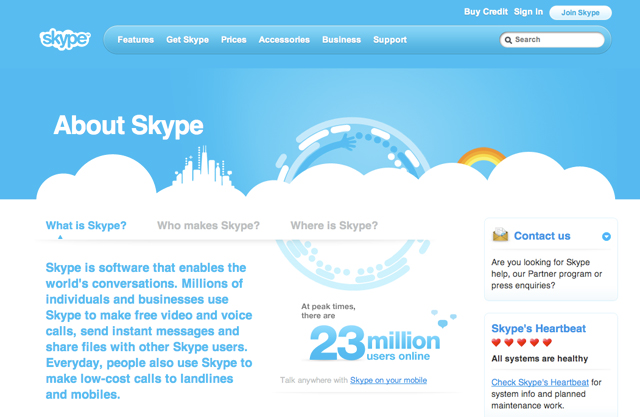Interviewing Tips & Strategies
#1 The 5 W’s & the H
Who? What? Where? When? Why? How? “I keep six honest serving-men, (They taught me all I knew); Their names are What and Why and When, And How and Where and Who” – Rudyard Kipling
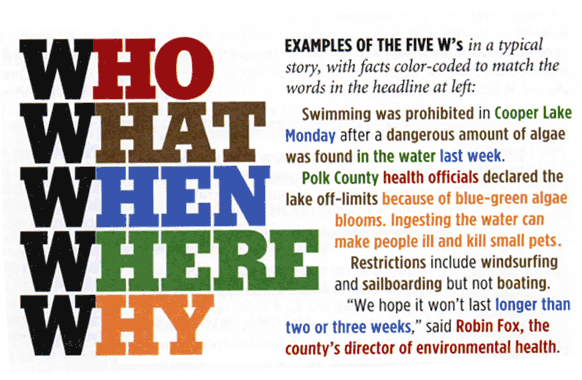
#2 AJR – What to Do
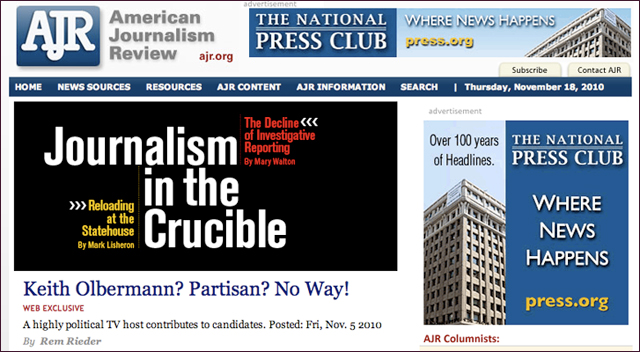
– Ask neutral, open-ended questions. Start questions with what, how and why; they demand the most from sources, requiring them to describe causes (what happened?), processes (how did it happen?) and motivation (why did you do it).
–Probe tough issues, don’t ask tough-sounding questions. Asking a subject “Are you a racist?” is an easy question that sounds tough. The answer most certainly will be no. Instead, ask focused, open-ended questions about evidence that suggests the source is a racist.
– Less is more. The more information journalists put into questions, the more information sources leave out. Short questions produce succinct, dramatic, focused responses. Long rambling questions get long rambling answers or curt, confused replies. (Related: Don’t finish your subject’s sentences or thoughts and leave some moments of silence where you subject might volunteer more information.)
– Strategize. Strategy becomes especially important when the issue is difficult. If you are going to ask questions that might make the subject feel embarrassed or ashamed, or defensive, find a way to get at the subject indirectly. (Related: Don’t be judgmental in your reaction or responses to answers.)
–Put the burden of proof on the source. If a source insists, “There was no crime,” ask, “How do you know that?” If a source says, “I can’t remember” ask, “Why can’t you remember?”
#3 AJR – What to Avoid
– Don’t make a statement instead of asking a question. Instead of asking: “It must have been tough in the early years,” ask: “What were the early years like?”
– Don’t ask double-barreled questions or two questions at once. “Whom did you like interviewing most and what’s your most impressive interviewing coup?”
– Don’t overload questions. The reporter asks Bill Clinton: “Was Gennifer Flowers your lover for 12 years?” He answers: “That allegation is false.”
–Don’t put comments into questions. Statements limit the journalist’s ability to get precise answers. Example: A reporter asks former hostage Terry Anderson about his captivity with others in Lebanon: “What would go through your mind in the quiet times? Because there must have been times when you didn’t talk to each other.” Anderson answers the comment: “Oh sure there were times when we didn’t talk to each other,” instead of the tougher question: “What went through your mind?”
– Don’t use trigger or loaded words in questions. The reporter begins a question to a member of Congress about a bill she is sponsoring: “Your scheme would allow for a huge windfall to oil companies…” “This is not a scheme,” she answers, responding to the loaded word “scheme” instead of the question.
–Don’t use hyperbole in questions.
Source: American Journalism Review
#4 Sure-Fire Openers
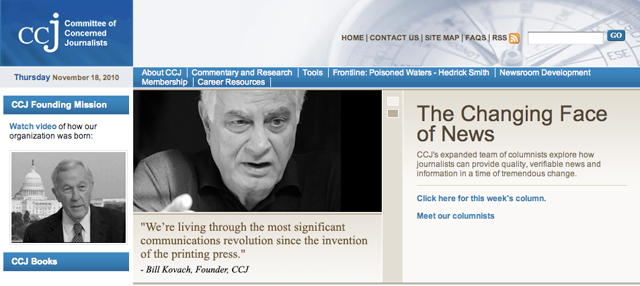
“Whenever I sense that the interview has hit an unresponsive snag and I am stuck with an inarticulate interviewee,” said the late freelance writer Mort Weisinger, “I resort to a gambit which has worked wonders. I simply say, ‘Mr. Jones, could you describe to me what you do on a typical day in your life, from the moment you get up until going to sleep at night?’ Brother, does this question move mountains!”
Barbara Walters once revealed to the New York Times her five “foolproof” questions for the over-interviewed:
– If you were recuperating in a hospital, who would you want in the bed next to you, excluding relatives?
– What was your first job?
– When was the last time you cried?
– Who was the first person you ever loved?
– What has given you the most pleasure in the last year?
There are multitudes of hypothetical questions, most of them or the office party strain. Some that may work in the rare, playful interview are:
– What three books (records, movies, presidents) would you take with you if you were stranded on an island?
– If you were fired from your present job, what sort of work would you undertake?
– If you could live any time in history, what age would you choose?
– If you could be anyone you wanted to be today, whom would you be, and what would you do?
– If someone gave you a million dollars, how would you spend it?
– If your house were afire, what would you grab on the way out?
Mrs. Dorothy Schiff, publisher and editor-in-chief of the New York Post, once suggested these human interest questions:
– What person influenced you most in life? What book, if any? What do you do for relaxation?
– What was your greatest opportunity?
– What do you believe about people – can they be changed for better or for worse?
#5 Loosening Lips – WNET Expose
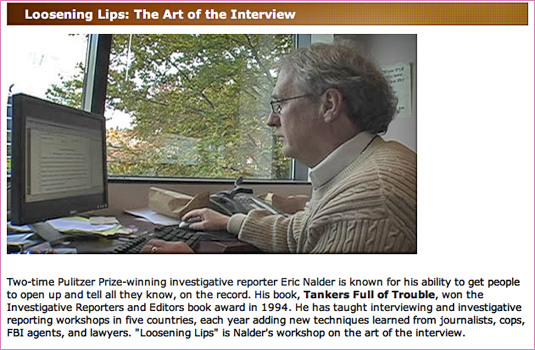
Eric Nalder, Chief Investigative Reporter – The Seattle Post-Intelligencer, July 9, 2007
Pulitzer Prize-winning reporter Eric Nalder shares his process for setting up and conducting effective interviews.
The Set Up
RESEARCH: Whether you have five minutes or five days, research the person and the topic. Run the name on the Internet or check the clips. Talk to the person’s cohorts. Read court records. A well-researched question is a better question. A well-researched interviewer is empowered.
PLAN: Make a tactical plan. Discuss it with colleagues. Whom should you interview first? Where will you interview the person? How much time will you have? Will you tape or not? The best place is usually where the person is doing the thing you are writing about. However, whistle-blowers and reluctant targets are best contacted at home. You might calm a nervous source by taking him or her for a walk. A lunch appointment requires a person to spend at least an hour with you. A phone interview is the least desirable, but also the most common.
ORGANIZE: Write single-word clues on the flap of your notebook to remind you of issues you want to cover. Organize paperwork so you won’t fumble as you talk. Prepare a comprehensive all-purpose question f cases or where the door might slam in your face. Prepare the photographer and the fellow interviewer so you will work together.
INNER INTERVIEWING: Imagine a successful interview. Warm up like an athlete. Be skeptical but never cynical. Believe and you will receive.
Reluctant People
THE OPENER: Having worked yourself into a friendly, courteous and aggressive frenzy, approach your subject as though you belong there. Straightforward introductions are best. Be open and unafraid. Never lie.
KEEP IT GOING: When the door is closing on your face, find common ground. “By the way, I notice you’ve got a poodle. I’ve got a poodle. Weird dogs. Just the other day . . .” The process is to get a person talking about anything and eventually they’ll talk about what you came for.
TAP THEIR CURIOSITY: As a person hangs up the phone, quickly offer to explain what you are working on, what you know about or what you have been told. Prepare for this ahead of time.
GET THEM TO SPEAK ABOUT OTHERS: Bring a list of other people to the interview. A payroll. A phone book. Your own list. Go down the list with the interview subject. People are more comfortable talking about others. In doing so, they will reveal more about themselves and their organization, and point you in other directions.
NO BIG DEAL: Respond to the “I can’t comment” by explaining that you need their help, that talking with you is no big deal, that you are talking with others and that you are here to learn (only, of course, if all of this is true). Say all this with a soft but relentless momentum. Massage objections into possibilities. Propose alternatives. Don’t argue. Steer. Keep the conversation rolling. Respond to the “I’m afraid to comment” with a little sympathy and a lot of reassurance (if those reassurances are honest). Listen to people’s concerns and understand them. Propose easier “assignments” like “just describe your job” or “tell me about your town.” You’ll get to the harder stuff later.
PUBLIC OFFICIAL OR OTHER BIG SHOT: Gently, without being insulting, respond to a “no comment” from an “important” person or bureaucrat by explaining how bad that sort of thing looks in print. “Let’s find a way to talk about this. Tell me about this one aspect, for instance.” As a last ditch, explain that you will be doing a story whether they cooperate or not (if that’s true). Explain that you want to get it right. Offer to call back shortly before the story runs to describe what will be in the story. (In the process, get all the contact numbers).
DETOURS: If a person won’t talk, go to others in his or her office or to associates. You will get more information, and by doing this you will loosen them up.
ANONYMITY: Don’t accept information “on background” blithely. Even if it means going back several times, convince people to go on the record. (Absolutely “off-the-record” information is useless, since you can’t use it under any circumstance. Avoid it. It’s a waste of time.)
RATCHETING: If a subject insists on talking “on background,” make a formal agreement and explain that you will try later to get them to talk on the record. Take notes. At the end of the interview, or at a follow-up interview, pick out quotes that aren’t too damning and say: “Now what about this thing you said here. Why can’t you say that on the record?” If they agree to put that comment on the record, go to another one in your notes and say: “Well, if you can say that on the record, why can’t you say this? And so on. I have gotten an entire notebook on the record this way. If they insist on anonymity, however, you must honor it.
THE STATUE OF LIBERTY PLAY: Emphasize that people are more believable when they put their name behind what they say. It’s the American Way: A robust public debate.
FOR THE SAKE OF CLARITY: There are cases where someone tells you part of a story and then balks. Or you already know part of a story and can’t get the rest. Try saying, “look, you’ve already told me this much (or, I already know this much). You had better tell me the rest. I mean, you don’t want me to get it wrong. I sure don’t want to get it wrong.”
NO QUESTIONS, PLEASE: Sometimes making a statement is better than asking a question. Read from a document or repeat something someone said. A question might produce nothing more than a “yes, no or I don’t know”, A statement will provoke a comment. On one occasion I inadvertently repeated something that was inaccurate to a cop. In correcting me, he dragged out a report I wanted to see.
USE WHAT YOU THINK YOU KNOW: Ask the official WHY he fired the whistle-blower rather than asking WHETHER he did the deed. The question presumes you already know even if you don’t have it confirmed. They’ll start explaining rather than denying.
LOST REPORTER: It doesn’t hurt to say you need the person’s help. “Who is going to explain this to me if you don’t?”
TRY AGAIN: When the door is slammed in your face, try again a day later or a week later. Keep trying. People change their minds. If it is terribly important, try again a year later.
Getting All the Goods
CHRONOLOGY: Take the subject through his or her story chronologically. You will understand the tale better, and you will spot gaps in the timetable. You’ll organize the interview subject, the way you would straighten a messy file cabinet.
LIFE STORY: Get the life story, even in cases where you don’t intend to use it. Even when I interview a lawyer about a case, or a bureaucrat about a government policy, I get the life story if I have time. I get useful information and ask better questions as a result.
LOGIC: Listen for logic. Respond to your instincts. If you don’t understand something, gently insist on an explanation. If a person uses A-C-D logic, ask that they fill in the “B” part. The most important information may be hidden in B. Don’t be afraid to ask. There are no embarrassing questions; there are only embarrassing answers.
HOW AND WHY: When a person says something important, ask the key question: “How do you know that?” It sheds light on credibility, extracts more detail and is a door opener to other sources. Follow up with: “How else do you know.” Also, ask people why they do what they do, rather than just asking what they do.
HYPNOSIS: When people reach an important part of a story, slow them down and turn them into storytellers. Ask where they were standing, what they were doing, what they were wearing, what was the temperature and what were the noises around them? Then switch to the present tense, and ask questions like: What are you doing now? What is your friend saying? You and the interview subject will walk through the scene together. This technique frequently fails at first. People prefer to tell their story the easy way, in the abstract. “I drove the car off the cliff.” Tell them this won’t work. “I’m trying, but I just can’t picture it yet. Drive me off the cliff with you.” This is how you get a story, not a bunch of facts.
PAY ATTENTION TO DETAIL: Inventory the room thoroughly and in an organized fashion. Look at the walls, read the top of the desk and study the lapel pin. You’ll get clues and details for your story. Make notes on what you see. Make use of what you see in the interview. Ask about it.
SPONTANEITY: If you are on the scene, let things happen. Listen and watch for the unexpected.
TELEPHONE: If you can’t be on the scene, ask people on the phone to describe their surroundings. This will transport you emotionally over the phone lines and provide information (the plaque on a man’s wall became a key detail in one story, after I had independently verified what it said). Get people to tell their stories in three dimensions over the phone. Let things happen. Listen and “watch” for the unexpected.
USE YOUR EARS: We talk too much during interviews. Let the other person do the talking. Check your biases at the door; listen with an open mind. React with an open mind.
LOOK FOR OTHER SOURCES: While at the interview, listen and watch for other sources. Meet the secretary, the assistants and the coworkers and make note of details about them. This will come in handy as you turn them into sources.
GETTING THE CONFESSION: Ask the subject for the names of people who support him or her. Then ask for the names of people who would criticize. Then ask what those critics are likely to say. This will jar loose uncomfortable information and tips. Ask whether the person has ever been disciplined or fired on the job or in school, charged with or convicted of a crime, arrested for drunken driving, sued, testified in court, etc. Since all this stuff is on a record somewhere, people are reluctant to lie about it.
LIARS: If you know someone is lying, allow the liar to spin his or her yarn. Don’t interrupt except to ask for more detail. Deceivers frequently provide extensive detail because they think a very complete story will add to their credibility. Listen and take good notes. When the lie has been fully constructed — down to the last nail — go back and logically pry it apart (nail by nail). Don’t be impatient. The fabricator is now in a corner. Keep them there until they break.
DON’T JOIN: Be sympathetic in manner, but don’t join sides with your sources. Protect your source from exposure, if you have promised to do so, but not from his or her dishonesty and ignorance. And don’t get sucked in by the embattled congressman who seems so cooperative when he grants you an interview and says, “I don’t believe in taking money from those guys.” You should say, “that may be true, but I’m asking you whether you took the money, not whether you believe in doing so.”
DON’T FEED: Be wary of feeding information to an interview subject. In some cases it will come back to you as fact. Cops will tell you: “Don’t ask whether a person saw the red car, ask what they saw.”
ASK AGAIN: Sometimes it pays to interview a person two or three times on the same subject. One public official gave me four different and conflicting explanations for the trips he took at taxpayer expense.
REVIEW: Go back over your notes and look for holes. Then conduct a second interview. Tell the interview subject what you believe you have learned. This will kick loose additional information, fill gaps and correct your mistakes. Do it again and again, if necessary. I like to get back to key players just before a story runs to assure accuracy. This last step has often improved the story.
INNOVATE: If an outrageous question comes to mind, and seems compelling, ask it. During a phone interview I convinced a man sitting in a bar with a cell phone to pass the phone around so I could talk with his companions. A ship captain allowed me to go through his files only because I asked.
DRAIN THEM: People aren’t aware of how much they know. You must guide them through their memory. Visualize your subject as a bucket full of information and empty it.
HONESTY: Don’t pretend to be someone else and don’t lie. You can certainly omit information, but the more you can reveal about the nature of your story, the more comfortable and helpful your subject will be.
BE THE DIRECTOR: A great interview feels like a conversation but moves relentlessly toward the information you need. Keep control, but do so gently.
BE FLEXIBLE: You may know what your story is about, but don’t get stuck. A really great interview might be one that completely changes your story. Seek the truth, not what you believe to be the truth.
PERSONALITY: Let your personality shine through (if you have a good one). Don’t be a blank wall.
OPEN-ENDED QUESTION: Near the end of an interview, ask the person what else our readers might be interested in. Sometimes people have more than one newspaper-worthy story in them.
CHECK BACK: After the story runs, call the subject for his or her reaction. You’ll get additional stories and tips this way.
#6 Guidelines For Interviewing Children – Reynolds Journalism Institute
In hopes of promoting a consistent understanding, here are some guidelines to keep in mind when you undertake reporting with children under 18:
Make sure you are clear with children about the fact that what they say may end up in print in the paper. Read it back to them. Let them hear what they said.
Err on the side of giving a child the benefit of the doubt. If a child says something that sounds out of line, go back at it and make sure she’s expressed herself the way she wanted to. And make sure the children you intend to quote have your contact information in case they want to clarify their statements, or their parents need to reach you.
Try to talk to the child’s parents prior to publication, in order to inform them of the interview and obtain their insights. If the parent objects to our planned use of the material, the matter should be discussed with an editor. Because the issue of parental consultation is a complicated one, here are some additional guidelines to follow when we intend to quote a child in the paper:
In schools: If you are reporting on a school campus or at a school event, the school’s own release forms (or, in some cases, refusal forms) should suffice for quoting older children. But it is still worth reaching parents for additional discussion if the child is 14 or younger, because not all parents pay much attention to forms that come home from school. And don’t underestimate the value of contacting parents in every case. Parents can help corroborate information and provide insight and context for how their children perceive things.
Note: While school officials often disagree, we do not consider it necessary to contact a parent merely to interview a child; the threshold is material we intend for publication.
Outside of schools: When we interview children of any age outside the context of school and intend to print their remarks, we should make every effort to contact the parents to inform them of our intention.
#7 National Reporter/Editor Conference: Editorially Speaking
The importance of chronological story-telling
Reporters should tell the subject, “Tell me the story from the beginning.” The subject will be less likely to leave out details, and if he or she does, the reporter will be more likely to spot the holes in the story.
When to interrupt
Reporters should interrupt the subject as little as possible, but here are three times when it is necessary:
– Tell the subject to slow down, to give more detail.
– Ask for details and specifics. (“What was his first name?” etc.)
– Pursue the how and why. (“How do you know that?” is a question reporters should ask more often.)
What to write down
I recommend dividing the interview notebook in half with a vertical line. Use the left half to take notes from the interview. U page se the other half for making personal notes, such as points to clarify later on.
I suggest that interview notes always contain at least three items:
– Direct quotes needed for the story.
– Basic factual information.
– Additional questions. (Put these on the right half of the page.)
Conversation versus laundry lists
Many reporters who make lists of questions prior to the interview (a good idea!) often let those questions drive the interview format. Reporters can get more information if they engage the subject in conversation because it promotes a more relaxed atmosphere. Cross off any laundry-list questions as they come up in the conversation and ask the missed questions at the end of the interview.
Thinking of questions while taking notes
This is difficult for many reporters – doing more than one thing at a time. This is when it is important to use the right half of the note pad to jot questions or buzz words for questions.
The worst possible question anyone could ask
Sometimes this simply is an embarrassing question; sometimes it is the crucial question (e.g., “Why did you kill her?”). If a reporter doesn’t ask the “worst possible question,” it should not be because of laziness or a timid nature. There should be a good reason.
Willingness to pause
One of my best reporters has a way of sitting silently after the subject has answered a question, making the subject so uncomfortable with the silence that he or she starts talking again. It’s an effective technique. Don’t always appear eager to get to the next question.
Getting the drama
We cringe when the television reporter’s first question is, “How do you feel?” Still, a reporter cannot write about emotion without knowing what was felt.
At appropriate points in the interview, ask the subject how he or she felt. Getting him or her to describe the scene at a news event often elicits an emotional response. Do this whether the interview is in person or on the telephone.
Asking who will be affected by this story
Reporters often ask an interview subject whom else to call, but asking who will be affected is likely to provide better, less biased sources for additional information.
Writing your story as you interview
Good reporters write the story in their head as they interview. Long before the end of the interview, they decide on a lead and focus for the story. Then, having been trained on the importance of the first five graphs, they make sure they have in their notebooks:
– Who, what, when, where and why
– The news and its impact
– The context
– The human dimension
– Quotes to back up what the story will say
– Validation and verification of the facts to be used in the story
Some final open-ended questions:
– “What should I have asked that I didn’t?”
– “What will be your response to your critics?”
– “Any points you want made?” Don’t promise to print them, but ask.
– For accuracy’s sake, say, “I may want to call you back. Are there any numbers I can use to reach you after office hours?”
#8 Weird and Wacky Interview Questions
– Why are manhole covers round?
– What would I find in your refrigerator right now?
– What is the last book you read?
– If you could trade places with any other person for a week, famous or not famous, living or dead, real or fictional. with whom would it be?
– If you could be any character in fiction, whom would you be?
– If you could be a superhero, what would you want your superpowers to be?
– If someone wrote a biography about you, what do you think the title should be?
– If you were a type of food, what type of food would you be?
– If you won $20 million in the lottery, what would you do with the money?
– If you were a car, what kind would you be?
– If you were written about in the newspaper, on the front page, what would the headline say?
– What makes you angry?
#9 Conducting interviews over e-mail or IM
Resource: No Matter the Format, Interviews Are Not Dying
Email advantages:
– Accuracy
– Convenience
– Speed
– Saves transcription time
Email disadvantages:
– No guarantee of authorship. Who are you really communicating with?
– You may not know if the subject received your email
– More work on subjects’ end — they have to type answers
– Harder to ask follow-up questions
– Can be hard to convey tone or emotion
Instant message advantages
– Better approximation of a conversation than e-mail
– Quick, allows for follow up questions, more natural dialogue
– Provides transcript
– For blowhards, may provide more succinct summary of situation
Instant message disadvantages
– No guarantee of authorship. Who are you really communicating with?
– More work on subjects’ end — they have to type answers
#10 Conducting interviews with Skype
Skype can be an interesting option for long-distance interviews or for interviews where the subject is reluctant to meet in person. A few features:
– video or voice only options
– free Skype to Skype calls (skype to phone costs .09 a minute)
– conferencing (video conferencing is in beta and may cost money after trial)
– sending files — images or documents — during an interview
– sending instant messages, hyperlinks
-screensharing: if you want to discuss a web site or document on a desktop, you can share your screen with your subject
There are various software options for recording your calls.
Resource: How to record Skype Calls
ecamm has a program called Call Recorder for Macs.
For PCs there are several programs, including EasyVoipRecorder Recorder. (Voip=Voice over Internet Protocol)

You can also record the interview using Audacity. The quality may vary.
Resources:
American Journalism Review Interview Techniques
National Reporter/Editor Conference: Editorially Speaking
Guidelines for Interviewing Children
Guidelines for Interviewing Juveniles
No Matter the Format, Interviews Are Not Dying
Great interviews of the 20th Century
Weird and Wacky Interview Questions
